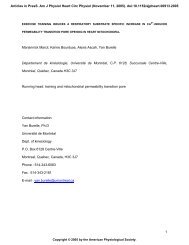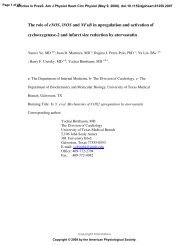Mitochondrial Creatine Kinase is Critically Necessary to Maintain ...
Mitochondrial Creatine Kinase is Critically Necessary to Maintain ...
Mitochondrial Creatine Kinase is Critically Necessary to Maintain ...
You also want an ePaper? Increase the reach of your titles
YUMPU automatically turns print PDFs into web optimized ePapers that Google loves.
Introduction<br />
MS H-00800-2001-R1<br />
<strong>Creatine</strong> kinase (CK, EC 2.7.2.2) <strong>is</strong> a key enzyme involved in energy metabol<strong>is</strong>m in t<strong>is</strong>sues with<br />
large fluctuations of energetic demand such as muscle or brain. CK catalyses the reversible<br />
transfer of a high-energy phosphoryl group between ATP and phosphocreatine (PCr). Four<br />
different <strong>is</strong>oenzymes of CK are known, three are dimers composed of 2 subunits (MM-CK, MB-<br />
CK and BB-CK), whereas sarcomeric mi<strong>to</strong>chondrial CK (ScCKmit) can form both dimers and<br />
octamers (for review see (28)). These <strong>is</strong>oenzymes are localized in a compartimentalized fashion<br />
in the cell. MM-CK, the most abundant muscle <strong>is</strong>oform, <strong>is</strong> a structural protein of the myofibrillar<br />
M-band. ScCKmit, the second most abundant <strong>is</strong>oform, <strong>is</strong> found on the outer surface of the inner<br />
mi<strong>to</strong>chondrial membrane forming a functional compartment with porin and the adenine<br />
nucleotide translocase (29). Th<strong>is</strong> character<strong>is</strong>tic spacial d<strong>is</strong>tribution has led <strong>to</strong> the “CK shuttle”<br />
hypothes<strong>is</strong>, where PCr serves as an energy transfer molecule for fast and efficient transport of<br />
phosphoryl moieties from the sites of energy generation (mi<strong>to</strong>chondria) <strong>to</strong> the sites of energy<br />
consumption (myofibrils and ion pumps) (1). On the other hand, the PCr-CK system has been<br />
generally regarded as a high-energy buffer system, that meets increased energetic requirements<br />
during periods of m<strong>is</strong>matched energy production and consumption. The physiological<br />
importance of the CK system in heart muscle <strong>is</strong> underlined by numerous reports of alterations in<br />
a variety of components of the PCr-CK system found in various animal models of heart failure as<br />
well as in human heart failure (10, 12-14).<br />
Despite several decades of research, however, the true nature of the fundamental role of CK,<br />
especially in d<strong>is</strong>ease states such as myopathies or heart failure, remains ill-defined. Transgenic<br />
animals with null mutations of one or more of the genes of the CK family may shed new light on<br />
the functional significance of the PCr-CK system. For example, skeletal muscle of mice lacking<br />
the M-subunit of CK, referred <strong>to</strong> here as M-CK -/- , demonstrate a transient impairment in<br />
contractile function (burst activity) (25). However, concentrations of high-energy phosphate<br />
4






